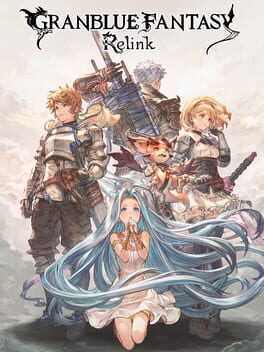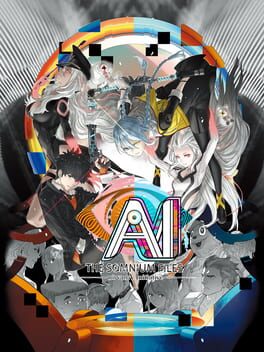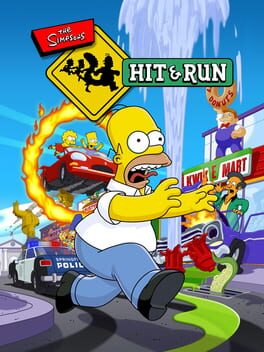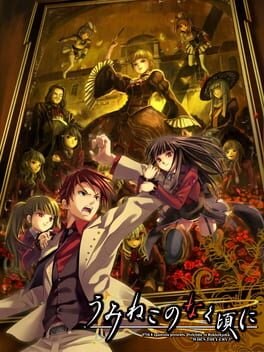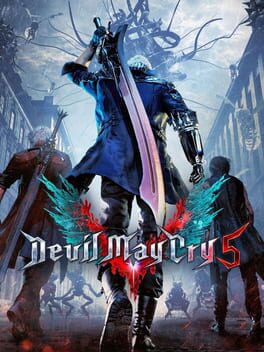Normal_Lee
9 reviews liked by Normal_Lee
This review contains spoilers
(co-written by my boyfie Lee as the culmination of numerous gripes & discussions since the game’s release)
The chief issue with Ai Nirvana stems from the literal plot twist upon which the narrative is built; the game was obviously written around the idea of this twist as opposed to using a genuinely compelling mystery or story as the framework. In the original game, the twist was a secret kept from the main character by another character, and upon its reveal, the true nature of the game’s events clicked into place. The twist of Ai Nirvana amounts to Uchikoshi fucking with you, the player, as evidenced by the awkward meta sequence where Mama has to address the player to explain it. The mystery of the murders is only a mystery because Uchikoshi went out of his way to present the game’s events in this way, thereby making them appear more interesting & compelling than they actually are.
The frustration doesn’t stem from feeling like I was successfully tricked, but because the twist, while technically impressive, accomplishes so little while hampering the rest of the narrative in order to accommodate its presence.
Ryuki and Tama are possibly burned the worst by this deal; as the new protagonists are a major selling point of the new game, and the designs are another pair of bangers from the desk of Yusuke Kozaki, it was disappointing that their only strengths are their individual personality quirks and brief one-off gags rather than a genuinely strong dynamic or story arc. Ryuki’s mental state deteriorates over the course of the story, culminating in his exploitation by the culprit; this leads to the expectation that this building pressure will come to a head and result in an explosive finale. However, after the twist is exposed, it is revealed that this plot-point had already been resolved off-screen, and all it takes is a few kind words from his hero to return Ryuki to his plucky self, robbing the conclusion of much-needed emotional gravitas.
Unrelated to the timeline twist, Tama’s potential as a character goes largely underutilized. Her design as a dominatrix-themed assistant would have lent itself well to a scene where she uses tough love to snap Ryuki out of his obsessive spiral. Instead, the most she does is Woman Standing Emoji at his breakdowns and reluctantly put up with his manias to a frustrating degree.
The type of writing required to execute a narrative trick such as the timeline twist necessitates sacrificing characterization in favor of prioritizing how the characters can contribute to said execution. Horadori is a character who appears annoyingly often for how early he dies, and his prevalence in the lives of the cast is never interrogated well enough to justify it. This is largely because his broader purpose is only to serve as a narrative black box from which much of the setup the twist requires can be pulled. He is responsible for Mizuki’s clone, Shoma’s immortality, and the technology which allows the murders to be presented the way they are; the latter requires the player to suspend their disbelief that a scientist capable of inventing CRISPR genes and manufacturing human beings thought that slicing two people in half and putting the separate halves together would produce a super-person.
Many of the wider ramifications of the timeline twist dangle embarrassingly off the sides of the game like paint peeling off the walls. Some astute players may notice that the masked woman is voiced by Mizuki, and may expect this revelation to amount to something, but Mizuki Kuranushi aka Mizuki 2 aka Big Sis aka Bibi aka Quartz is mostly just a victim of Uchikoshi’s ambitions. In a similar vein, Shoma’s immortality is not actually relevant to the plot in any meaningful way; when he reveals it to Mizuki, she essentially replies “ermmm O_o okeyyyy” and leaves. Finally, Tokiko gets wrapped up in the murders, but Uchi still needs a pseudoscience vendor, so she keeps a hologram around that’s programmed to posthumously spout bullshit whenever any of the detectives show up.
The new cast is largely a mixed bag; Lien and Kizuna stand out as possibly the worst newcomers. Kizuna is seemingly only present to have someone to tie to the new pop song, and is such an obnoxiously flat & stale character that when she was first introduced I was convinced the twist was going to be that she was a literal robot. Lien serves as a love interest to support the game’s theme of duality, but also doubles as a narrative lockpick to get the detectives where the story wants them to be, usually Horadori Institute. The game can never really sell them as a couple since their bond is predicated on Lien being stubborn and not taking no for an answer.
A lot of the previous game’s holdover characters and locations are only present because it’s more cost-effective to utilize existing assets in a sequel. However, Iris and Ota are a special case, as they get their own unique timeskip designs. They have a great moment where Iris sings the funny Fortnite song. Did you know that because of the nature of the timeline twist, these timeskip designs can only appear in Mizuki’s route on days that do not cross over into the past route? This prevents them from having any effect on the story at all, making their presence in this game amount to a novelty!
-LEE ROUTE-
Holdovers extend beyond just these physical assets, however. I (Lee) played the first game and this one back to back- as in, I played AITSF for the first time, and the next day started playing Nirvana Initiative- and playing the games in such close proximity to each other does nothing but harm the experience of playing Nirvana Initiative. Mainly, so many of the jokes in Nirvana Initiative are just the exact same jokes that were already in the first game, sometimes to the point of literally being copied verbatim, with the only new twist on the joke (assuming there even is one) usually just being that a different character is saying it compared to the first game. Granted, there were some instances of this that got a genuine laugh out of me, such as when Tama tries egging on Ryuki to sniff Hitomi’s shoebox (this being something you could do as Date in the first game) and Ryuki basically responds, “No, why would I do that, what is wrong with you.”
With any level of restraint, these could be perfectly fine “Easter egg” jokes that appear infrequently and reference a joke from the first game to highlight similarities or differences between characters across the two games, but before long this type of joke starts to feel like the norm for the humor in Nirvana Initiative. Examine the high table at Lemniscate? “Hi table” pun. Examine a sofa? “Do re mi.” Examine the beer crates at Ota’s diner? Ota makes a comment implying he wants Iris to stand on one so he can look up her skirt.
This could be far worse, as none of these jokes really require you to have played the first game to understand them (which is good, since this game is meant to be playable independently of the first game), but if you’ve played the first game in remote proximity to this one, you’ll start to feel like half or more of the jokes are just ones you’ve already seen or heard before. I’m sure the actual percentage isn’t that high, but it happens so often that you can’t help but feel like it’s getting in the way of the actual original jokes that Nirvana Initiative has, and you eventually start to think to yourself “yes I know this already please just get on with it.”
Unfortunately, this feeling of “get on with it” doesn’t stop with the repetitiveness of the humor. Many investigation segments, especially while playing as Ryuki, end with you learning little, if any, new information. In sections where you have a list of locations you need to visit and investigate, it’s not uncommon for these to end with even the characters themselves saying, “Man we didn’t learn shit, huh?” Often, the only “new” information you may get is pseudoscience explanations, and even then these will repeat across multiple different gameplay sections, so if you take a shot every time a character talks about the Mandela effect and the collective consciousness you will probably die before you switch to Mizuki.
Not only that, but a decent number of Somniums will also end with you learning something you basically already knew, but characters will act like this is a significant piece of new information. In the first game, the things you learned in Somniums were not only clearly related to the case, but also actually gave you a decent chunk of new information to work with, and the reason you needed to look inside someone’s head to begin with was always clear. With Nirvana Initiative, if you put a gun to my head I probably wouldn’t be able to tell you what you learn from more than half the Somniums, because it’s usually, at best, something incredibly inconsequential.
Even the justifications for certain characters having a Somnium at all can feel very flimsy, to the point where characters in-game will sometimes basically say “can we look inside your brain for the sake of your character arc.” Shoma’s, Kizuna’s, and Lien’s Somniums in particular come to mind as I write this. Admittedly, it is possible that there is some important information learned from at least one of these Somniums, but the justifications for and information obtained from each Somnium are generally so flimsy that they can be easy to forget!
-LEE ROUTE END-
More oddities that result from AITSF holdover characters include the taxi driver instigating the most egregious case of tonal whiplash in any of Uchikoshi’s works to date, Hitomi getting to be in the big dance number at the end with a bunch of strangers despite appearing maybe two or three times in the story to tell you she has no idea what you’re talking about, and responsibility for the murders being tied back to So Sejima again for no reason. The game also seemingly tries to retread story beats from the original, with mixed results; Shoma’s Somnium is a weak imitation of Mizuki’s Somnium and pales in comparison to Mayumi’s on an emotional level, and the attempt to retread Aiba’s death fakeout from the first game with Ryuki is really pathetic and sad and reads as a fakeout so immediately that I have no idea why they even bothered.
The game still has plenty of merits to keep it from getting too low a score. The Somniums in particular are a huge step up from those of the original game (despite this game featuring a strong contender for worst Somnium in the series). While they may at first seem somewhat linear/railroaded compared to the more open-ended original Somniums, they benefit from being more tightly designed puzzles as opposed to what were often quite frustrating gambles on dream logic. When Nirvana isn’t aping old jokes, it maintains the humor and charm of the first game. Amame’s arc is jaw-dropping brilliance and Gen is a strong character as well. I conceived of more or less all of my gripes with this game in retrospect; I enjoyed my playthrough thoroughly, though I was likely just riding the high of getting another Ai game at all, which I never thought was a possibility given the typical sales performance of Uchikoshi’s titles. Even so, what I expected would be an easy GOTY contender ended up being a major disappointment and a huge step down from the game that wowed and charmed me years prior.
The chief issue with Ai Nirvana stems from the literal plot twist upon which the narrative is built; the game was obviously written around the idea of this twist as opposed to using a genuinely compelling mystery or story as the framework. In the original game, the twist was a secret kept from the main character by another character, and upon its reveal, the true nature of the game’s events clicked into place. The twist of Ai Nirvana amounts to Uchikoshi fucking with you, the player, as evidenced by the awkward meta sequence where Mama has to address the player to explain it. The mystery of the murders is only a mystery because Uchikoshi went out of his way to present the game’s events in this way, thereby making them appear more interesting & compelling than they actually are.
The frustration doesn’t stem from feeling like I was successfully tricked, but because the twist, while technically impressive, accomplishes so little while hampering the rest of the narrative in order to accommodate its presence.
Ryuki and Tama are possibly burned the worst by this deal; as the new protagonists are a major selling point of the new game, and the designs are another pair of bangers from the desk of Yusuke Kozaki, it was disappointing that their only strengths are their individual personality quirks and brief one-off gags rather than a genuinely strong dynamic or story arc. Ryuki’s mental state deteriorates over the course of the story, culminating in his exploitation by the culprit; this leads to the expectation that this building pressure will come to a head and result in an explosive finale. However, after the twist is exposed, it is revealed that this plot-point had already been resolved off-screen, and all it takes is a few kind words from his hero to return Ryuki to his plucky self, robbing the conclusion of much-needed emotional gravitas.
Unrelated to the timeline twist, Tama’s potential as a character goes largely underutilized. Her design as a dominatrix-themed assistant would have lent itself well to a scene where she uses tough love to snap Ryuki out of his obsessive spiral. Instead, the most she does is Woman Standing Emoji at his breakdowns and reluctantly put up with his manias to a frustrating degree.
The type of writing required to execute a narrative trick such as the timeline twist necessitates sacrificing characterization in favor of prioritizing how the characters can contribute to said execution. Horadori is a character who appears annoyingly often for how early he dies, and his prevalence in the lives of the cast is never interrogated well enough to justify it. This is largely because his broader purpose is only to serve as a narrative black box from which much of the setup the twist requires can be pulled. He is responsible for Mizuki’s clone, Shoma’s immortality, and the technology which allows the murders to be presented the way they are; the latter requires the player to suspend their disbelief that a scientist capable of inventing CRISPR genes and manufacturing human beings thought that slicing two people in half and putting the separate halves together would produce a super-person.
Many of the wider ramifications of the timeline twist dangle embarrassingly off the sides of the game like paint peeling off the walls. Some astute players may notice that the masked woman is voiced by Mizuki, and may expect this revelation to amount to something, but Mizuki Kuranushi aka Mizuki 2 aka Big Sis aka Bibi aka Quartz is mostly just a victim of Uchikoshi’s ambitions. In a similar vein, Shoma’s immortality is not actually relevant to the plot in any meaningful way; when he reveals it to Mizuki, she essentially replies “ermmm O_o okeyyyy” and leaves. Finally, Tokiko gets wrapped up in the murders, but Uchi still needs a pseudoscience vendor, so she keeps a hologram around that’s programmed to posthumously spout bullshit whenever any of the detectives show up.
The new cast is largely a mixed bag; Lien and Kizuna stand out as possibly the worst newcomers. Kizuna is seemingly only present to have someone to tie to the new pop song, and is such an obnoxiously flat & stale character that when she was first introduced I was convinced the twist was going to be that she was a literal robot. Lien serves as a love interest to support the game’s theme of duality, but also doubles as a narrative lockpick to get the detectives where the story wants them to be, usually Horadori Institute. The game can never really sell them as a couple since their bond is predicated on Lien being stubborn and not taking no for an answer.
A lot of the previous game’s holdover characters and locations are only present because it’s more cost-effective to utilize existing assets in a sequel. However, Iris and Ota are a special case, as they get their own unique timeskip designs. They have a great moment where Iris sings the funny Fortnite song. Did you know that because of the nature of the timeline twist, these timeskip designs can only appear in Mizuki’s route on days that do not cross over into the past route? This prevents them from having any effect on the story at all, making their presence in this game amount to a novelty!
-LEE ROUTE-
Holdovers extend beyond just these physical assets, however. I (Lee) played the first game and this one back to back- as in, I played AITSF for the first time, and the next day started playing Nirvana Initiative- and playing the games in such close proximity to each other does nothing but harm the experience of playing Nirvana Initiative. Mainly, so many of the jokes in Nirvana Initiative are just the exact same jokes that were already in the first game, sometimes to the point of literally being copied verbatim, with the only new twist on the joke (assuming there even is one) usually just being that a different character is saying it compared to the first game. Granted, there were some instances of this that got a genuine laugh out of me, such as when Tama tries egging on Ryuki to sniff Hitomi’s shoebox (this being something you could do as Date in the first game) and Ryuki basically responds, “No, why would I do that, what is wrong with you.”
With any level of restraint, these could be perfectly fine “Easter egg” jokes that appear infrequently and reference a joke from the first game to highlight similarities or differences between characters across the two games, but before long this type of joke starts to feel like the norm for the humor in Nirvana Initiative. Examine the high table at Lemniscate? “Hi table” pun. Examine a sofa? “Do re mi.” Examine the beer crates at Ota’s diner? Ota makes a comment implying he wants Iris to stand on one so he can look up her skirt.
This could be far worse, as none of these jokes really require you to have played the first game to understand them (which is good, since this game is meant to be playable independently of the first game), but if you’ve played the first game in remote proximity to this one, you’ll start to feel like half or more of the jokes are just ones you’ve already seen or heard before. I’m sure the actual percentage isn’t that high, but it happens so often that you can’t help but feel like it’s getting in the way of the actual original jokes that Nirvana Initiative has, and you eventually start to think to yourself “yes I know this already please just get on with it.”
Unfortunately, this feeling of “get on with it” doesn’t stop with the repetitiveness of the humor. Many investigation segments, especially while playing as Ryuki, end with you learning little, if any, new information. In sections where you have a list of locations you need to visit and investigate, it’s not uncommon for these to end with even the characters themselves saying, “Man we didn’t learn shit, huh?” Often, the only “new” information you may get is pseudoscience explanations, and even then these will repeat across multiple different gameplay sections, so if you take a shot every time a character talks about the Mandela effect and the collective consciousness you will probably die before you switch to Mizuki.
Not only that, but a decent number of Somniums will also end with you learning something you basically already knew, but characters will act like this is a significant piece of new information. In the first game, the things you learned in Somniums were not only clearly related to the case, but also actually gave you a decent chunk of new information to work with, and the reason you needed to look inside someone’s head to begin with was always clear. With Nirvana Initiative, if you put a gun to my head I probably wouldn’t be able to tell you what you learn from more than half the Somniums, because it’s usually, at best, something incredibly inconsequential.
Even the justifications for certain characters having a Somnium at all can feel very flimsy, to the point where characters in-game will sometimes basically say “can we look inside your brain for the sake of your character arc.” Shoma’s, Kizuna’s, and Lien’s Somniums in particular come to mind as I write this. Admittedly, it is possible that there is some important information learned from at least one of these Somniums, but the justifications for and information obtained from each Somnium are generally so flimsy that they can be easy to forget!
-LEE ROUTE END-
More oddities that result from AITSF holdover characters include the taxi driver instigating the most egregious case of tonal whiplash in any of Uchikoshi’s works to date, Hitomi getting to be in the big dance number at the end with a bunch of strangers despite appearing maybe two or three times in the story to tell you she has no idea what you’re talking about, and responsibility for the murders being tied back to So Sejima again for no reason. The game also seemingly tries to retread story beats from the original, with mixed results; Shoma’s Somnium is a weak imitation of Mizuki’s Somnium and pales in comparison to Mayumi’s on an emotional level, and the attempt to retread Aiba’s death fakeout from the first game with Ryuki is really pathetic and sad and reads as a fakeout so immediately that I have no idea why they even bothered.
The game still has plenty of merits to keep it from getting too low a score. The Somniums in particular are a huge step up from those of the original game (despite this game featuring a strong contender for worst Somnium in the series). While they may at first seem somewhat linear/railroaded compared to the more open-ended original Somniums, they benefit from being more tightly designed puzzles as opposed to what were often quite frustrating gambles on dream logic. When Nirvana isn’t aping old jokes, it maintains the humor and charm of the first game. Amame’s arc is jaw-dropping brilliance and Gen is a strong character as well. I conceived of more or less all of my gripes with this game in retrospect; I enjoyed my playthrough thoroughly, though I was likely just riding the high of getting another Ai game at all, which I never thought was a possibility given the typical sales performance of Uchikoshi’s titles. Even so, what I expected would be an easy GOTY contender ended up being a major disappointment and a huge step down from the game that wowed and charmed me years prior.
